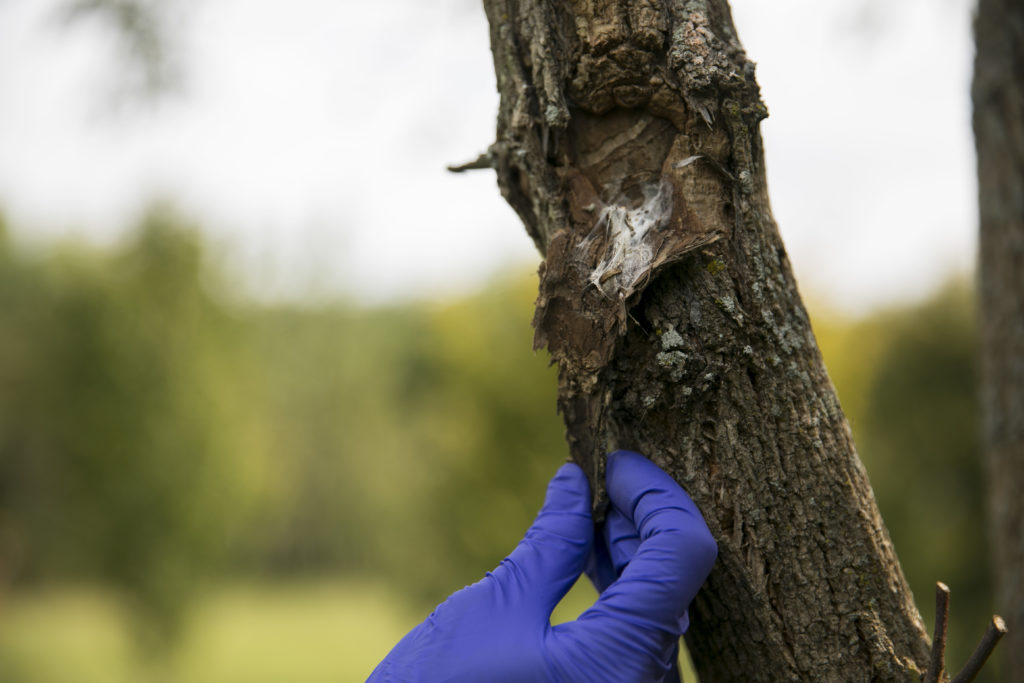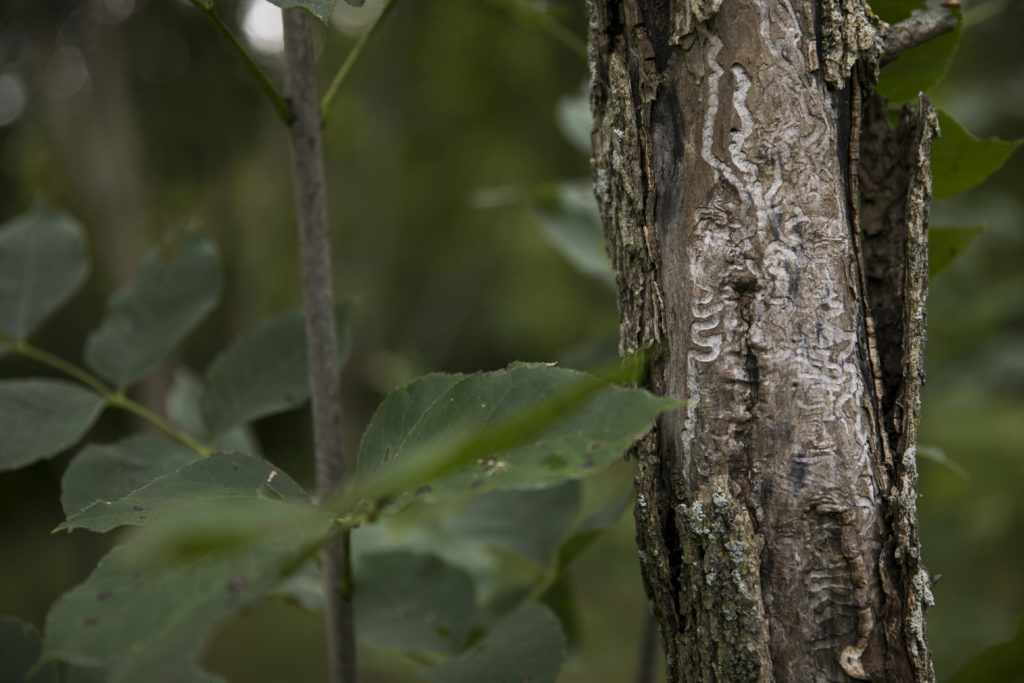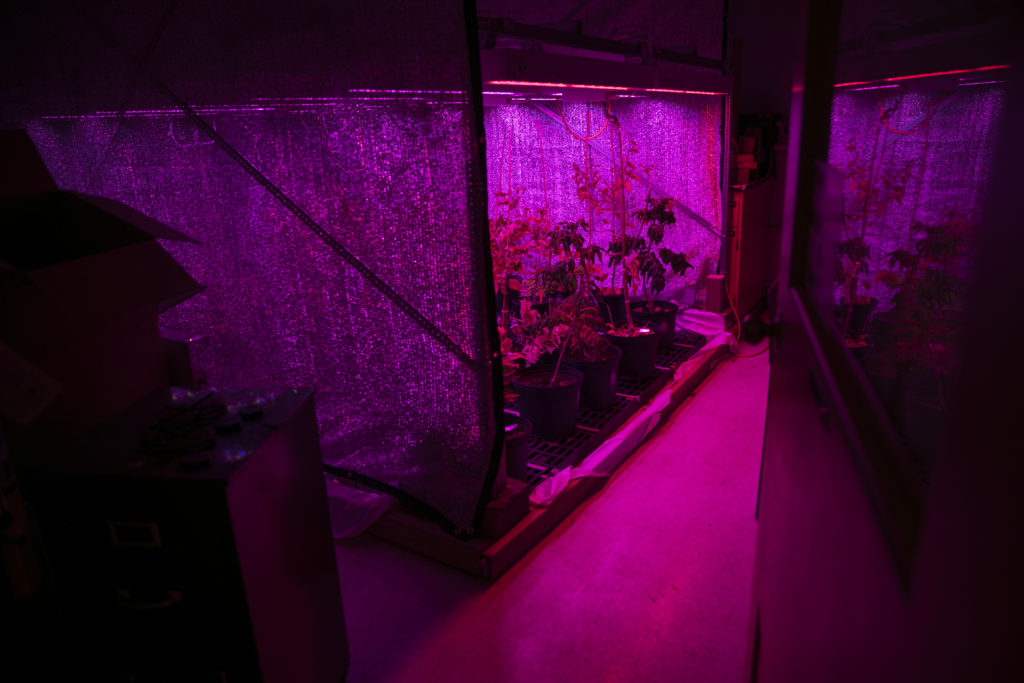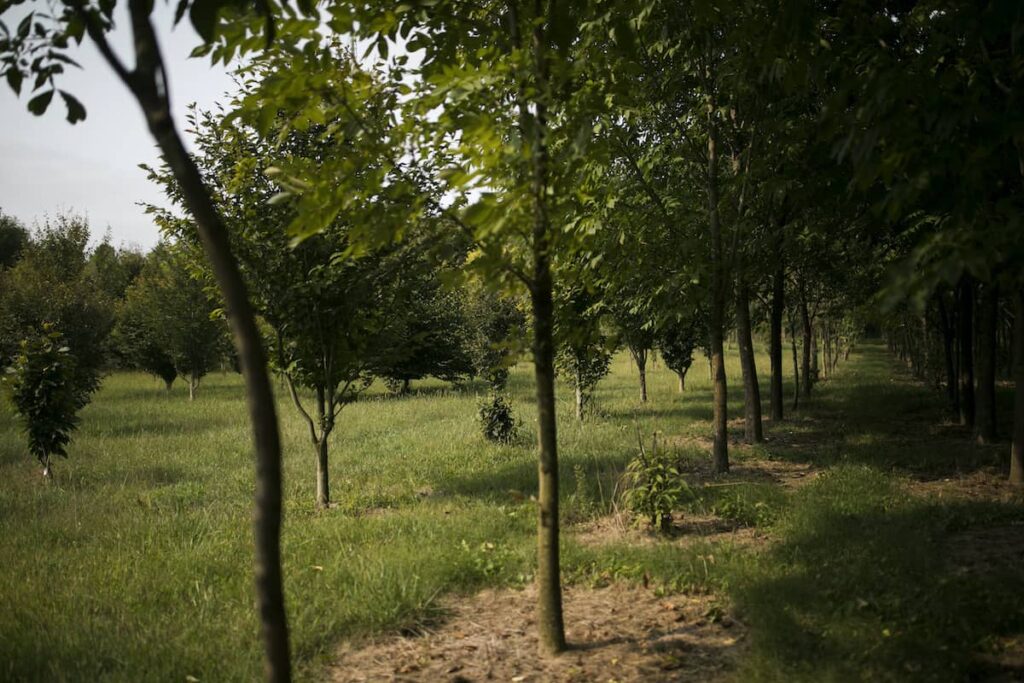Last updated on February 2nd, 2024
This article originally appeared in American Forests Magazine.
Jennifer Koch, a research biologist with the U.S. Forest Service’s Northern Research Station in Delaware, Ohio, carefully peels back the outer layer of the bark of an ash tree with the tip of a grafting knife. The work is slow; she must be gentle or risk severing the tiny, wormlike white larvae that she is trying to find underneath.
These larvae are the offspring of an insect native to Asia called the emerald ash borer (EAB), which is surprisingly beautiful for a pest responsible for the brutal devastation of one of the most common tree species in the United States. The slim, half-inch-long insect’s bright, metallic green wings overlay an orangey-crimson abdomen — a festive combination that belies the destruction these insects are bringing to ash trees from Maryland to Wisconsin.
The pest appeared in the U.S. in 2002, and began decimating Detroit’s tree canopy. Since then, the EAB has destroyed hundreds of millions of trees nationwide. Jeff Hafner, director of municipal consulting for Rainbow Treecare in Minneapolis-St. Paul, and a certified arborist, watched in horror as the pest swept across Michigan and Ohio. In Minnesota, authorities targeted ash trees for removal, but the size of the coming onslaught overwhelmed some cities’ ability to manage.
“A lot of the cities in Minnesota increased their condemnation policies to enforce more rapid tagged tree removal,” he says. “We’ve seen cities that have had to abandon their tree condemnation protocol because they just don’t have enough staff to tag all the trees that need to be removed.”
In the context of such a major threat, Koch’s bioassay is part of an effort to stave off the extinction of this pervasive and important tree species — a project called Roots of Rock on which American Forests is collaborating with a range of partners. The effort aims to change the way we approach tree cultivation in the face of a changing climate and the pest outbreaks and forest fires fueled by it. Ultimately, scientists hope to breed trees that will withstand the EAB assault over time.
The Best Measure of Resistance
Once Koch has peeled the top layer of bark away, it’s clear that the impact of these tiny larvae isn’t tiny at all: Underneath is a network of tunnels etched into the wood — called a gallery — that indicates the pathways that the larvae have taken over for the last year or two since their parents deposited their eggs on the bark. The larvae feed on the tree’s vascular tissue, disrupting its ability to transport water and nutrients to its branches, a process that kills it, usually in as little as 5 to 7 years.


Scientists believe that the emerald ash borer kills nearly all of the ash trees it infests, though it has become clear that some put up a fight and don’t die quite as quickly as others. These trees, referred to as “lingering ash,” are scarce and have managed to survive the fatal attack of EAB. The goal of the research is to identify what defense responses these trees mount against the larvae that allows these rare trees to survive. Such insight will help accelerate the process of breeding, producing trees with even more resilience to EAB.
Scientists believe that the emerald ash borer kills nearly all of the ash trees it infests. But some, referred to as “lingering ash,” don’t die as quickly.
Trees that show some resistance may still die from EAB infestation, but they live longer. If 1 in 4 larvae dies at a young age due to the tree’s natural defenses, that tree sustains 25% less damage from larval feeding and can, thus, potentially live 25% longer than other trees.
The process of the bioassay — one of several techniques the scientists are using — involves putting eggs on the bark of the ash trees, where they hatch within 48 hours and burrow in. After two weeks, scientists mark those that have hatched and circle their entry holes. Eight weeks later, once the larvae have had a chance to feed, the scientists dissect the tree starting at the holes to see the gallery. When they find a larva, they take its weight and examine its development and health. If a larva appears unhealthy or the galleries immediately around the larvae are darkened in color and tissue from the tree is encasing the larvae, it’s a sign that the tree is putting up resistance to the pest.
“The best measure of resistance that is most reproducible is the number of tree-killed larvae,” says Koch. “If they have partial resistance, they live longer than the majority of ash trees in the stand, but they can still be attacked by EAB and may die. Through breeding these select lingering ash trees, we can increase the number of larvae that the seedlings of two lingering ash parents are able to kill and, thus, increase their resistance to EAB.”
This painstaking effort to look at the inner workings of this pest seems to be paying off, providing a way to cultivate trees that are better able to withstand a climate-altered future where pest outbreaks like the EAB are sure to be increasingly common.
“Our program has shown that we can create improved populations that can survive and continue to evolve and save the species,” says Koch. “We’ve developed these techniques and shown that these processes work.”
The Importance of Healthy Ash
As one of the most dominant native genera of trees in North America, ash is essential for environmental benefits, Tree Equity and industry uses. These trees help maintain a healthy environment; the widespread mortality of the species resulting from emerald ash borer infestation is altering the carbon cycle and shifting water resources. The program’s name, Roots of Rock, is a nod to the vital importance of ash trees to the music industry, which makes instruments out of ash wood. And ash’s decline is also affecting urban areas, where this common tree type provides shade and clean air to neighborhoods around the country.

“Here you have a species that is not only native to North America, but found in almost every state throughout the nation,” says Eboni Hall, senior manager of urban forestry education at American Forests. “Ash is a keystone species that’s invaluable to its surroundings. It’s important in terms of climate change and providing co-benefits. That’s where we’re starting to see some of the negative implications and consequences of losing this species.”
Hafner agrees that ash has tremendous benefits for urban communities, though many of those advantages are taken for granted. “I am always sad to lose big, mature trees from communities because it’s the trees’ proximity to people that gives maximum benefit,” he says. “I think the good news is that this issue is impacting so many people that there is opportunity to highlight tree benefits which may have been invisible to people for a long time.”
As a common tree that can typically thrive in the urban jungle, ash is a critical species for efforts to advance Tree Equity, which is the equitable distribution of trees in urban areas to ensure that all people can benefit from them. American Forests’ work on this front includes using a Tree Equity Score to determine which neighborhoods need more trees and to target those areas for planting.
Once those trees are in the ground, it’s essential that they are able to survive so that the investment pays off and future generations can experience the benefits trees provide. There’s a similar calculus that goes into reforestation efforts after wildfire — the last thing conservationists want is to plant trees to restore fire-ravaged forests only to have them destroyed by pests.
“We’re thinking through every piece of Tree Equity,” says Ian Leahy, vice president of urban forestry at American Forests. “We’re not looking for people to make investments in Tree Equity in a community and then a pest comes through and wipes all the progress out.”
Tree Equity and reforestation work is only as good as the health of the trees being planted, so it’s a worthy goal to find varieties of ash that are as resistant as possible to diseases and pests. Although ash trees can temporarily be protected by applying insecticides — as Hafner works with city leaders to do in Minnesota — the only long-term solution for restoring ash populations internationally is to breed ash trees for resistance to the emerald ash borer.
The Roots of Rock Project Rocks
Accordingly, the work Koch and her team are doing is the initial stage of a multi-part effort to get ash trees with some amount of resistance to the emerald ash borer into the ground in order to identify and cultivate those that are most resilient. Koch’s team selected and bred green ash trees that showed signs of resistance, and some of them were able to kill more than 95% of the emerald ash borer larvae in bioassays.

The next phase is to see how these EAB-resistant trees perform in urban planting environments, where the trees will be exposed to more realistic conditions than they are in greenhouse tests, where they are grown in a controlled environment. American Forests is partnering with the Forest Service, Holden Forests & Gardens, Washington & Jefferson College, The Greening of Detroit, Wholesale Trees Inc., Wayne State University, and the Detroit Department of Neighborhoods to orchestrate this project.
A first planting of 150 trees, each around 4 or 5 years old and 5 feet tall, went into the ground in spring of 2021 in a nursery in Virginia Park, an urban site in Detroit. A second planting of trees about 2 years old and 2 feet tall occurred at Detroit’s Palmer Park, Eliza Howell Park and The Greening of Detroit’s Meyers Nursery at Rouge Park in late 2021. The trees were planted in pairs — one tree of each pair with genetics that make it susceptible to EAB and the other tree with genetics that show some resistance — providing the first chance to see a direct comparison between the two types.
“They’re urban pilot plantings,” says Mary Mason, a geneticist with the Forest Service who is working on the project. “We know some of them won’t make it, but we hope a few will. We’ll get a little bit of data out of it.”
New Uses for an Established Approach
That data will move forward the work of selecting trees with pest-resistant genetics. The scientists are careful to clarify that there’s no such things as “immune” trees; there are only trees that can kill enough larvae to reduce the threat and prolong the tree’s life.
By selecting these trees and propagating them through grafting, the project can increase the frequency and level of EAB-resistance within the population, and little by little the resistance can grow stronger over time through natural selection. Once the effort produces trees that are clearly more pest-defensive than others, those exemplars can be used to develop regional clonal seed orchards where genetically improved seeds can mass produce the more resilient trees for urban plantings and reforestation work.
This approach is not new; the history of tree improvement programs like this goes back decades at the Forest Service. A program to increase resistance in all white pine species in the U.S. to a disease called white pine blister rust has been running for some 50 years. That work provided proof of concept, and the need for this work has only increased as climate change has become an increasingly dire threat. In a changing climate, diseases are emerging more often and more virulently.
Accordingly, American Forests will also support research efforts, technology transfer projects and downstream restoration activities for other threatened keystone species, such as Eastern hemlock, American beech, American elm and American chestnut in national forests and in urban areas. These future projects will use the knowledge gained from the work on EAB.
“We’re not looking for people to make investments in Tree Equity in a community and then a pest comes through and wipes all the progress out.”
Ian Leahy, Vice President of Urban Forestry, American Forests
One example of such an effort is the Great Lakes Basin Forest Health Collaborative, a network of partners assisting with all the different aspects of resistance breeding. Members of this network are currently taking the activities of Koch’s EAB project and expanding them to develop seed orchards to supply EAB-resistant seed for restoration in various regions of the country. When appropriate, once enough research has been done to map the path forward, similar efforts will be focused on American beech and Eastern hemlock.
Benefiting Future Generations
Roots of Rock and related efforts are serving to accelerate discovery of genetic resistance to pests and diseases, as well as amplifying the story of how climate change is increasing the prevalence and strength of such threats.
By supporting the fight against the emerald ash borer and other damaging pests, American Forests and its partners are bringing solutions to the ground level and finding ways for reforestation efforts to have the greatest possible longevity.
“The benefits of planting trees won’t be realized until later for future generations,” says Leahy. “This way, the trees will actually be able to mature and will be able to deliver on their promise of helping those who need them most.”
That’s a goal worth grafting for.
Katherine Gustafson is a freelance writer specializing in helping mission-driven changemakers like tech disruptors and dynamic nonprofits tell their stories.
For more information about the impact climate-change fueled pest and pathogen outbreaks are having on U.S. forest carbon stocks, read USN4C’s blog article New Research Highlights the Carbon Losses to U.S. Forests Caused by Pests and Pathogens and How We Can Reduce These Threats.
